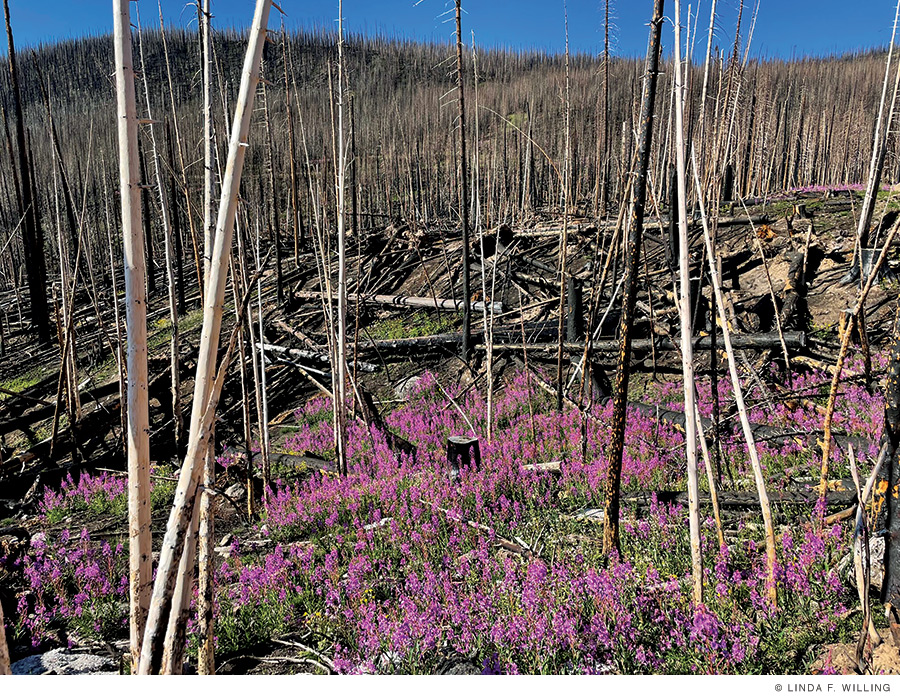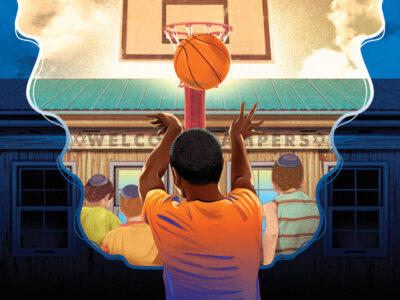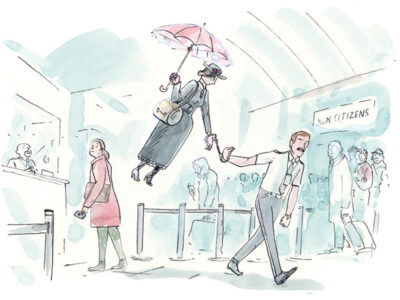
The forest will come back. Just not in my lifetime.
By Linda F. Willing
When the East Troublesome fire roared through my mountain neighborhood on October 21, 2020, I was sure that our house would be destroyed. It wasn’t—due to a combination of good luck and the efforts of brave firefighters who worked through the night to save buildings, even as some of their own homes burned. In less than 24 hours, 28 houses burned in my neighborhood. All told, nearly 500 structures were lost in what turned out to be the second-largest wildfire in Colorado history.
I did not lose my house that night. But I often feel I have lost my home.
We built our cabin in this mountain community nearly 30 years ago, drawn to the beauty of the natural environment and the opportunity to explore it on hundreds of miles of trails that wind through protected lands—national forests, a premier national park, and locally preserved areas.
I have walked these trails dozens—in some cases, hundreds—of times. Some of them are so familiar to me that I feel I could walk them blindfolded. And yet when I first ventured out after the fire, I felt I was in a different world. On a different planet.
Not a single tree survived for miles. The ones left standing had been bent over by hurricane-force winds and then locked in that position by the sudden intense heat. Trees burned so hot that their stumps burned holes in the ground, leaving sterile black pits. Roads and buildings that had never been previously visible stood out in stark relief against the monochromatic landscape.
But these are my trails. So I walk them again, and gradually they become familiar in their new form. It’s been two years since the fire, and much of the ground is green with opportunistic plants—grasses first, then dandelions and thistles, and now an abundance of wildflowers: lupine and oxeye daisies and wild rose. They crowd the spaces between scorched boulders whose surfaces have flaked off like layers of onion, and ghost trees curved like barrel staves. And this past summer I noticed something else: the first finger-high shoots of pine trees, returning to their native habitat.
It will all come back. Fire is a natural force here, even if the East Troublesome blaze was determined to be human caused. Fires have swept through these mountains countless times over the centuries, renewing the landscape, making way for new, healthy forests to thrive. So it will all come back—just not in my lifetime.
I will never see it again. Not as it once was, not as it exists in my memory.
It’s a strange feeling to know, for a fact, that something will never happen again in my lifetime. That a place that was as familiar to me as my own reflection in the mirror will remain a foreign land to the end of my days on this earth. I’ve already seen this place, as I know it, for the last time.
This comes as a shock, but it shouldn’t. I’ve already done many things for the last time in my life. I was doing things for the last time even when I was a teenager exploring the world around me at Penn and it seemed that the only reality was one of possibility and the future. I never thought of endings then. I was only looking ahead. Even as we age, we always think there’s at least a chance that we might return to a place, or see someone again, or hear a favorite musician play. And if we cannot do these things—because the friend moved on or the musician stopped touring—it’s because they changed, not us.
In 1978, I climbed Mount St. Helens in Washington State and spent the night on the summit. Two years later a volcanic eruption dissolved that summit into smoke and ash, carried by the winds to settle in distant places—even on the sidewalks and gardens in my Colorado neighborhood. I’ve always liked the feeling of having spent a night in a place that no longer exists. The summit is gone, but I am still here.
I remember, in elementary school, being told that the sun would burn out in five billion years. What a sense of panic I had in that moment—the sun was going away!—until I was reassured that five billion years was the same as eternity, and the star’s death would have no impact on me.
I let it go, that first glimpse of mortality at age seven. But that feeling now returns to me, walking these trails. Not only that things will end, but that some things have already ended.
The visceral knowledge of this fact makes every footstep on these trails feel strange to me. Of course, I acknowledge my own mortality. It’s an undeniable reality. I’ve lost people close to me. I see and feel the effects of aging every day.
Yet, at a deeper level, I’ve never really believed it. And I think this is true for most people.
One of my oldest friends died last year after a long battle with cancer. In the months leading up to his death we talked often about mortality. It bothered Steve to think that all his memories would be lost after he was gone—all the unique experiences and adventures he’d had. It wasn’t so much that he wanted to live indefinitely into the future; on the contrary, he hated the idea of completely losing the past.
I suggested that perhaps consciousness is conserved after death in some way. He was neither convinced nor consoled.
I know the feeling. As I walk these trails, I am confronted with the loss of my own experiences here, my memories, my sense of place and home. How tall will these young trees be when I am ultimately gone?
Perhaps the loss of our memories is like the fire that ravaged these trails two years ago. They are burned, vaporized, and yet the falling ashes will somehow nurture the next generation of life that continues on without us.
Linda Willing C’76 is a former urban firefighter, National Park Service backcountry ranger, and the author of On the Line: Women Firefighters Tell Their Stories.




